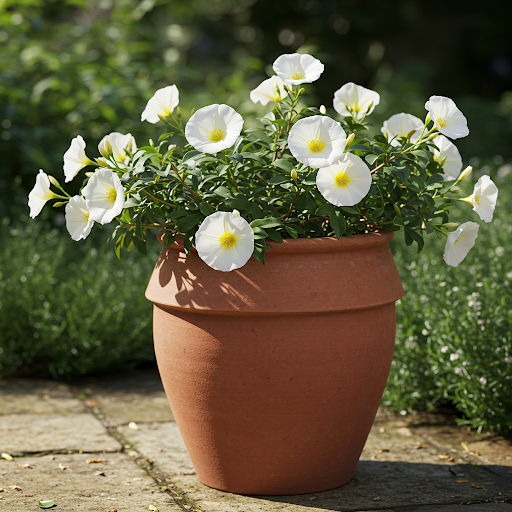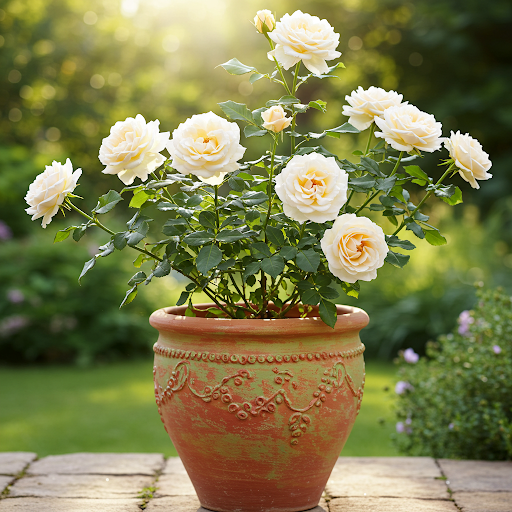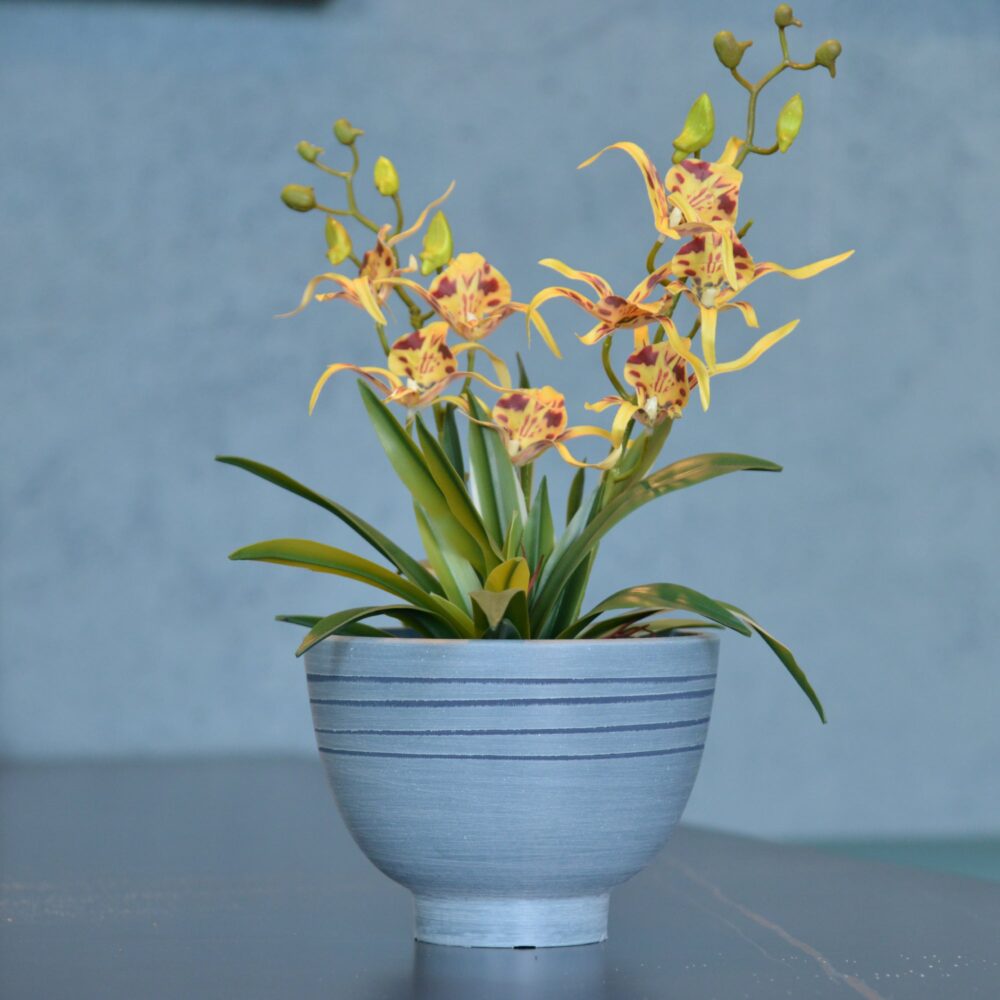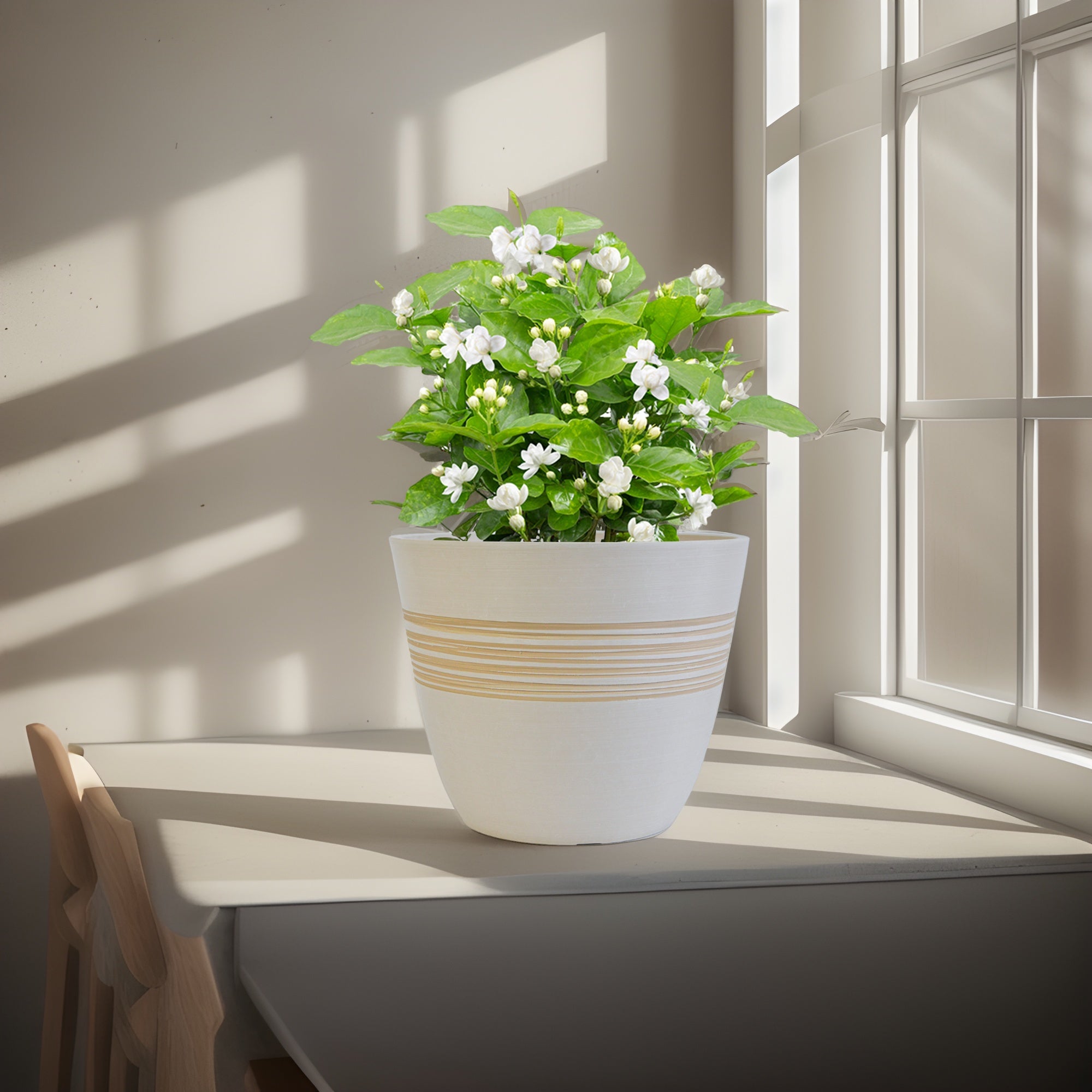Roses in Pots: The Complete Guide to Growing Roses Outdoors in Containers (Fragrant & Beautiful!)
Want to fill your patio, balcony, or garden with classic beauty and intoxicating fragrance? Growing Roses in containers is a wonderfully rewarding way to bring these timeless and beloved flowers into your outdoor spaces. Celebrated for their exquisite blooms in a vast array of colors and forms, their rich fragrance, their long flowering season, and their adaptability to container gardening, Roses are perfect for adding a touch of romance and elegance to your outdoor living areas. This comprehensive guide will provide you with everything you need to know to grow Roses successfully in outdoor pots, from selecting the best types and containers to mastering essential care techniques for a fragrant and beautiful display.

Roses
What are Roses?
Roses are beloved flowering shrubs and climbing plants belonging to the genus Rosa in the Rosaceae family. With thousands of cultivars and varieties, they are among the most popular and widely cultivated ornamental plants in the world, prized for their exquisite flowers, diverse colors and forms, rich fragrances, and long history of cultural significance. Rose bushes are characterized by their thorny stems, compound leaves, and beautiful flowers that range in form from single to fully double, and in size from miniature to large and showy. Flowers come in an extraordinary spectrum of colors, including red, pink, yellow, orange, white, purple, and bi-colors. They exhibit a wide range of growth habits, from compact shrubs to tall bushes and climbing vines, making them versatile for various garden styles and spaces. Roses are known for their symbolism of love and beauty, their diverse uses in gardens, bouquets, perfumes, and even culinary applications, and their ability to evoke a sense of romance and classic elegance. Different types of roses include Hybrid Tea Roses, Floribunda Roses, Grandiflora Roses, Miniature Roses, Patio Roses, Climbing Roses, and Old Garden Roses, each with unique characteristics and suitability for different purposes.
Are Roses Good for Outdoor Pots?
Yes, Roses are exceptionally well-suited for outdoor pots and container gardening, and is a popular choice for adding beauty and fragrance to patios, balconies, and other paved areas. Their adaptability to pruning, manageable size in containers (especially certain types), prolific flowering, and fragrant blooms make them ideal for container cultivation. Growing Roses in pots offers several advantages:
- Ideal for Small Spaces: Container gardening allows you to enjoy roses even if you have limited garden space, such as on balconies, patios, or decks.
- Portability: Potted Roses can be easily moved to optimal locations for sunlight, display, or shelter from extreme weather. You can rearrange them to create stunning focal points or seasonal displays.
- Controlled Environment: Container gardening allows you to provide the specific well-draining, fertile soil mix that Roses prefer and control watering and fertilization more precisely, which is important for their health and flowering.
- Design Versatility: Roses in pots can be used as standalone specimen plants, grouped together for a massed display, or incorporated into mixed container arrangements with other plants.
- Pest and Disease Management: Container growing can help reduce some soilborne pest and disease issues that can affect Roses planted directly in the ground.
- Ideal for Patios and Balconies: Roses in pots are perfect for adding a touch of classic elegance and intoxicating fragrance to patios, balconies, and other outdoor living spaces, creating a romantic and inviting atmosphere.
- Cold Climate Flexibility: In regions with colder winters, potted Roses can be easily moved to a sheltered location, such as a garage or unheated greenhouse, to protect them from harsh winter conditions and ensure their survival.
Ideal Growing Conditions for Roses in Pots:
Types of Roses for Pots: While many types of roses can be grown in containers, some are better suited than others due to their size and growth habit:
- Patio Roses: Bred specifically for containers, Patio Roses are compact, bushy, and floriferous, reaching about 1-3 feet tall. They are excellent for pots and small spaces.
- Miniature Roses: Very small and compact, typically 6-18 inches tall, Miniature Roses are ideal for smaller pots and window boxes. They offer a wide range of colors and forms.
- Floribunda Roses: Bushy and prolific bloomers, Floribunda Roses are generally more compact than Hybrid Teas, reaching 2-4 feet tall, and are well-suited for medium to large containers.
- Hybrid Tea Roses (Select Varieties): Some more compact Hybrid Tea varieties can be grown in large containers, but choose carefully and be prepared for more pruning and management. Look for varieties described as “bushy” or “compact” for Hybrid Teas in pots.
- Avoid very vigorous Climbing Roses in pots unless you have very large containers and are prepared for extensive pruning and training. Shrub Roses can be grown in pots, but choose more compact varieties and be mindful of their mature size.
Light: Roses demand full sun to thrive and bloom profusely. They need at least 6-8 hours of direct sunlight per day, and ideally even more. Choose the sunniest location possible for your Rose containers, such as a south-facing patio, balcony, or garden. Inadequate sunlight will result in weak growth, fewer flowers, and increased susceptibility to diseases. Full sun is absolutely essential for abundant blooms and healthy, vigorous plants.
Soil: Roses need well-draining, fertile soil that is rich in organic matter. Use a high-quality potting mixspecifically formulated for roses, or a premium general-purpose potting mix amended for roses. Amend potting mix with compost, well-rotted manure, and peat moss or coco coir to improve fertility, drainage, and water retention. Good drainage is crucial to prevent root rot, especially in containers. Roses prefer slightly acidic soil with a pH of around 6.0-6.5.
Watering: Roses need consistent moisture, especially when actively growing and blooming in containers. Water deeply and regularly, especially during dry periods and hot weather. Water thoroughly when the top inch of soil feels slightly dry. Water deeply until water drains out of the drainage holes. Then, allow the topsoil to slightly dry before watering again. Avoid overwatering and consistently soggy soil, but also avoid prolonged drought stress, which can weaken plants and reduce flowering. Container-grown plants will dry out faster than those in the ground, so monitor soil moisture regularly. Water more frequently during hot, sunny weather and peak bloom. Water less frequently during cooler, cloudier periods and in winter dormancy. Water at the base of the plant to avoid wetting foliage, which can encourage fungal diseases.
Temperature: Roses thrive in moderate temperatures, ideally between 60-80°F (15-27°C) during the growing season. They are generally hardy in a wide range of climates, but extreme heat or cold can stress them. In Singapore’s consistently warm climate, temperature is generally suitable for many rose varieties, although some may appreciate some afternoon shade during the hottest periods. Ensure good air circulation, especially in humid climates like Singapore, to help prevent fungal diseases.
Humidity: Roses prefer moderate humidity. High humidity can increase the risk of fungal diseases like black spot and powdery mildew. Ensure good air circulation around potted roses, especially in humid climates like Singapore, by spacing pots adequately and choosing open locations.
Fertilizer: Roses are heavy feeders and require regular fertilization to support their vigorous growth and abundant, repeat flowering, especially when grown in containers. Fertilize every 2-4 weeks during the active growing and blooming season (spring through fall). Use a balanced rose fertilizer (granular or liquid) or a general-purpose fertilizer with micronutrients, following product label instructions for roses. Alternatively, you can use a combination of slow-release granular fertilizer in spring and supplement with liquid feed every few weeks during the blooming season. Fertilizers formulated for roses often have a slightly higher phosphorus content (the middle number) to encourage flowering. Stop fertilizing in late summer or early fall to allow plants to prepare for dormancy. Regular feeding is crucial for healthy growth, strong repeat blooms, and vibrant flower color in container roses.
Choosing the Right Pots for Roses:
Suitable Pot Types: Roses can be grown in various pot types, but drainage, size, and stability are key considerations. Suitable pot types include:
- Terracotta Pots: Terracotta is a good choice as it provides excellent drainage and aeration, helping to prevent overwatering, and offers a classic, elegant look that complements roses. Larger, heavier terracotta pots are recommended for stability, especially for larger rose bushes.
- Ceramic Pots: Glazed or unglazed ceramic pots can be used, offering a wide range of decorative styles. Ensure they have drainage holes and are sturdy enough for the plant size. Choose based on your desired aesthetic and stability needs.
- Resin Pots: Lightweight, durable, available in styles mimicking terracotta or ceramic, and offer a balance of drainage and moisture retention. Resin pots are a good alternative to heavy terracotta or ceramic, and often more durable than terracotta or plastic. Choose sturdy resin pots.
- Plastic Pots (Sturdy): Sturdy, good quality plastic pots can be used, especially for larger plants, as they are lightweight and durable. Ensure excellent drainage and be careful not to overwater in plastic pots as they retain moisture. Dark-colored plastic pots can heat up excessively in full sun in hot climates, so lighter colors may be preferable.
Drainage: Excellent drainage is absolutely essential for Roses to prevent root rot. Ensure your chosen pot has multiple drainage holes at the bottom. Avoid pots without drainage holes. Always use a drainage layer at the base of the pot (e.g., a layer of gravel or pot shards) beneath the potting mix to further enhance drainage. Elevating pots slightly on pot feet or bricks can also improve drainage and air circulation.
Pot Size: Choose pot sizes appropriate for the type of rose and its mature size. Roses need sufficient root space to thrive and bloom well.
- Patio and Miniature Roses: Start with pots that are at least 10-12 inches in diameter and depth.
- Floribunda and Hybrid Tea Roses: Use pots that are at least 16-20 inches in diameter and depth, and ideally larger (20-24 inches or more) for Hybrid Teas or larger Floribundas.
- Larger Roses (Shrub Roses, etc.): For larger rose types, use pots that are 20-24 inches in diameter and depth or larger. The larger the pot, the better for long-term growth and flowering, especially for more vigorous rose types.
- Depth: Pots should be at least 12-18 inches deep for Patio and Miniature Roses, and 18-24 inches deep or more for Floribunda, Hybrid Tea, and larger roses to accommodate their root systems.
Stability: Roses, especially larger bushes, can become top-heavy, particularly when in full bloom. Stability is a crucial consideration, especially for outdoor containers exposed to wind. Choose heavy pots made of terracotta, ceramic, or sturdy resin. Wider pots are generally more stable than tall, narrow pots. Consider placing pots in sheltered locations or using plant supports if needed.
Color and Style: Choose pot colors and styles that complement the flower colors of your Roses and your outdoor décor, and enhance their classic, romantic appearance. Classic terracotta, white, cream, pastel, or subtly colored pots often work well, allowing the rose blooms to be the main focal point. Elegant, decorative pots can enhance the overall aesthetic. Consider the style of your patio or balcony and choose pots that harmonize with the surroundings and enhance the desired romantic, classic garden ambiance.
Essential Care Tips for Thriving Roses in Outdoor Pots:
- Watering: “Water Regularly, Allow Topsoil to Slightly Dry Between Waterings”. Water thoroughly when the top inch of soil is slightly dry during the growing season. Water deeply and ensure good drainage. Allow topsoil to slightly dry between waterings. Avoid overwatering.
- Sunlight: Provide Full Sun (at least 6-8 Hours Daily) for Best Blooms. Place Rose pots in the sunniest location possible. Full sun is essential for abundant flowering and healthy growth.
- Fertilizing: Fertilize Every 2-4 Weeks During Growing Season with Balanced Rose Fertilizer. Fertilize regularly during the spring and summer growing season to promote healthy growth and abundant flowering. Use a balanced rose fertilizer.
- Pruning (Regular Pruning for Shape and Bloom): Prune Roses regularly to maintain desired shape and size, remove dead or diseased wood, and encourage new growth and more blooms. Prune in late winter or early spring (dormant pruning) to shape the bush and remove dead wood. Deadhead spent flowers regularly during the blooming season to encourage repeat flowering. Light pruning can be done throughout the growing season to remove dead or crossing branches.
- Deadheading (Encourage Repeat Bloom): Deadhead spent flowers promptly by cutting the stem just below the faded bloom and above the first set of five leaves. This encourages the plant to produce more flowers instead of seed hips.
- Pest and Disease Control (Monitor and Treat as Needed): Monitor Roses regularly for common pests and diseases, such as aphids, spider mites, black spot, and powdery mildew. Treat promptly with appropriate insecticides or fungicides if infestations or diseases occur. Good air circulation, proper watering, and healthy plants are the best defense against pests and diseases.
- Winter Care (Protect in Cold Climates): In Singapore, no winter protection is needed. In regions with cold winters, provide winter protection for potted roses. This may involve moving pots to a sheltered location (garage, unheated greenhouse), mulching around the base of the plants, or wrapping pots to insulate the roots from freezing temperatures. Check specific winter care needs for your rose type and climate.
Popular Rose Cultivars for Pots (by Type and Color):
- Patio Roses (Compact & Floriferous): ‘Flower Carpet’ series (various colors, disease-resistant), ‘Knock Out’ series (various colors, very disease-resistant, low maintenance), ‘Oso Easy’ series (various colors, very disease-resistant, single to semi-double flowers).
- Miniature Roses (Small & Charming): ‘Jeanne Lajoie’ (pink blend climber, can be grown as a small bush in a pot), ‘Cupcake’ (pink), ‘Sweet Dream’ (orange blend), ‘Yellow Doll’ (yellow).
- Floribunda Roses (Clusters of Blooms): ‘Iceberg’ (white, classic floribunda), ‘Julia Child’ (butter gold, fragrant), ‘Playboy’ (orange blend), ‘Sexy Rexy’ (pink).
- Hybrid Tea Roses (Select Compact Varieties): ‘Perfume Factory’ (lavender blend, fragrant, more compact Hybrid Tea), ‘Dick Clark’ (red blend), ‘Veterans’ Honor’ (red), ‘Mister Lincoln’ (dark red, fragrant, may need larger pot and more pruning).
In Summary:
Growing Roses in outdoor pots is a wonderfully rewarding way to create a fragrant and beautiful garden display on your patio, balcony, or in any sunny outdoor space. Their exquisite blooms, diverse colors, and intoxicating fragrance bring classic elegance and romance to container gardens. By selecting suitable rose types (Patio, Miniature, Floribunda), providing full sun, well-draining, fertile potting mix in pots with excellent drainage and stability, regular watering and fertilization during the growing season, and consistent pruning and deadheading, you can easily cultivate thriving and beautifully blooming Rose plants in pots and enjoy their timeless beauty and fragrance in your outdoor living spaces for years to come.

Roses
For more detailed botanical information and to explore the diverse world of Roses, you can visit the Wikipedia page on Rose.
Important Note: The key to success with Roses in pots is providing ample sunlight, ensuring excellent drainage to prevent root rot, consistent watering and feeding, and regular pruning and deadheading to encourage repeat blooms. With proper care and attention to their specific needs, your potted Roses will reward you with an abundance of fragrant and beautiful flowers, bringing classic garden beauty to your outdoor living areas!
k2-21G
By greenship|2024-08-13T06:17:26+00:00August 13, 2024|Categories: Hand-carving Series|
11V
By greenship|2024-08-13T03:05:48+00:00August 13, 2024|Categories: Hand-carving Series|
8 inch/10 inch Planter Indoor Plants, 2 Pack Modern Decorative Plant Pots with Drainage Hole, Cute Bowl Shape Flower Pots
By greenship-seo|2025-04-10T08:03:42+00:00January 9, 2025|Categories: Hand-carving Series|Tags: Decorative Flower Pots, Self-Watering Pots|
HS
By greenship|2024-08-13T06:45:17+00:00August 13, 2024|Categories: Hand-carving Series|
20T
By greenship|2024-08-13T06:42:22+00:00August 13, 2024|Categories: Hand-carving Series|
Planter for Indoor Outdoor Plants, Set of 2 Modern Decorative Plant Pots with Drainage Hole, Decorative Flower Pots
By greenship-seo|2025-04-10T07:46:01+00:00January 9, 2025|Categories: Hand-carving Series|Tags: Decorative Flower Pots, Self-Watering Pots|






